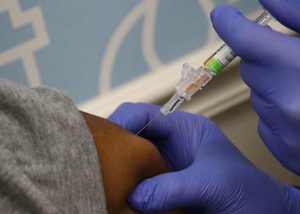By Yvaine Ye
Medill Reports
Baby boomers, Gen X-ers and millennials hardly ever agree with each other on the same issue, but more than half of them have found common ground on the flu vaccine. They are not fans.
More than 7,000 people died as a result of flu and flu-related disorders such as lung disease from 2010 to 2015, according to the Centers for Disease Control and Prevention. The virus also sent approximately 2 million people to the hospital in the same time period. Sure, everyone hates getting the flu, but only 43 percent of U.S. adults received a flu shot last year.
Even though the flu vaccine remains the one of the most effective preventive measures for staving off the virus, whose severity ranges from “call in sick for work” to death, why do so few Americans get one yearly? Much of this has more to do with “mistrust of the vaccine and a lot of misinformation about the safety and efficacy of the vaccine,” said Michael Ison, an infectious disease professor at Northwestern University.

For many the biggest sticking point of the vaccine, besides the needle, is the idea of injecting yourself with precisely the thing your body is trying to avoid.
Yet that’s exactly how the flu shot is designed to work. In order to train your immune system to become more efficient and effective during an actual infection, dead virus pieces are injected into your body. This is why many people feel a little bit sick after the flu shot — the body is going through a military exercise to prepare for future attacks.
To many, introducing virus into health body for future protection is unnecessary and counterintuitive. “The body can handle just about everything,” said Amy Sherwood, 41, who hasn’t received a flu shot since she was a kid. “Why put a dead virus inside you to fight off a live virus? That’s what white blood cells are for. Let them do the work.”
Sherwood is not alone – the numbers among her age cohort tell a similar story of flu shot reluctance. Only 32 percent of people age 18 to 49 received a flu shot in the 2015-2016 flu season, according to the CDC. That’s the lowest vaccine coverage of any age group.
“I’m 25 years old, I’m healthy, and I take very good care of my body,” said Michael Levi, a student at Tufts University in Boston. “I don’t think I’m really at risk of coming down with the flu or spreading it to others.”
However, for reasons that scientists have yet to find out, younger individuals who have lower risk of being infected, tend to experience the flu more profoundly when they do contract it, said Ison. “It’s quite clear that H1N1 still is causing severe disease in otherwise healthy young adults,” he said.
The CDC estimated that a 5-percentage-point increase in vaccine coverage among adults aged 18 to 64 could slash the flu illness number by 300,000 during the 2015-2016 flu season.
Rumors and Risk
Thanks to social media, old wives’ tales and outright falsehoods, the flu shot is perhaps only slightly more popular than the flu itself. For example, much digital ink has been spilled about the miniscule amount of mercury present in the vaccination.
Mercury is a toxic heavy metal that can damage human nerves and organs. Functioning as a preservative, a mercury-containing compound called thimerosal is added to vaccines to prevent the growth of bacteria. Because the amount of thimerosal is so minimal, and thimerosal — different from other mercury-containing compounds — “does not build up and reach harmful levels,” according to the CDC, doctors see little cause for concern when it comes to vaccine safety.
“You expose yourself to more mercury eating a tuna fish sandwich than you are getting a flu vaccine,” said infectious disease professor Michael Ison.
However, many remain skeptical.
“There might be risk,” said student Michael Levi, “and continually exposing yourself to it might place you at a greater risk of developing an adverse reaction or potentially weakening your immune system when the intention of the flu shot is to protect you.”
Not so fast, medical experts say. Vaccinations, rather than weaken your immunity, are building the body up for future fights. In fact, those who eschew flu shots are not just putting their health at risk, but also the health of those around them.
Herd Mentality
The virus is less able to spread within a community where most of its members are vaccinated. Such community, or herd, immunity provides greater protection to those who are at higher risk for the flu, such as young children and the elderly. However, the lack of conversation on community responsibility contributes to the lack of awareness in getting the flu shot.
“People are looking at this as an individual benefit and an individual risk,” said Jennifer Reich, a professor of sociology at the University of Colorado Denver, who studies the anti-vaccination movement. “They are also not thinking of this as a choice that might matter to other people around them.”
This is not an easy gap to close. Despite the CDC’s relentless effort, the flu vaccine coverage among U.S. adults has remained flat since 2010, with slight year-to-year fluctuations between 38 to 44 percent. The numbers fall woefully short of the 80 percent coverage target set by the Department of Health and Human Services.
Mistrust of the vaccine, and a host of misinformation about its safety and efficacy, will remain as an ongoing battle for health care professionals when they urge more to get a yearly flu shot. Until then, all they can do is to keep spreading the word.
“Continue to have the conversations,” Reich said of the communication gap. “Young adults think about how things would change for them if they were incapacitated for 10 days, which is about how long influenza lasts. If we have more conversations like that it may shift people’s understanding.”


